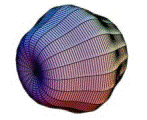Department of Physics and Astronomy: Publications and Other Research
Date of this Version
April 1981
Abstract
We have measured the alignment of beam-foil collision-excited states of He I produced by bombarding carbon foils of various (1.3-110 μg/cm2) areal densities with beams of He+ and HeH+. In addition, we have measured the total light yield of several transitions in He I, He II, and H as a function of foil thickness using beams of HeH+ ions. Experiments were done with He-foil exit energies of 125, 500, 550, and 650 keV. He I alignment decreases in all cases for the thinnest foils when molecular projectiles are used. Total light intensities generally increase with thin foils (small proton-He emergent internuclear separation), but a few decrease or are independent of foil thickness. We are able to explain several features of the alignment and intensity data in terms of the formation of quasimolecular HeH+ states at or near the foil surface. Alignment reduction results from incoherent Stark mixing of the He I excited states in the field of the close proton. A calculation of the rms emergent H-He internuclear separation as a function of foil thickness and beam energy is presented.


Comments
Published in Phys. Rev. A 23, 1761 - 1774 (1981) [Issue 4 – April 1981]. ©1981 The American Physical Society. Used by permission.